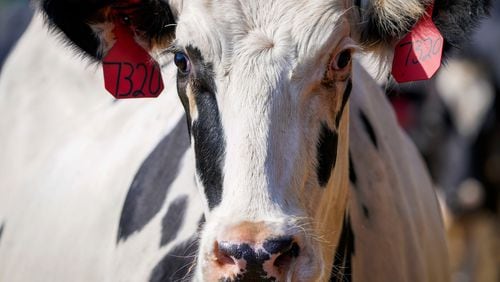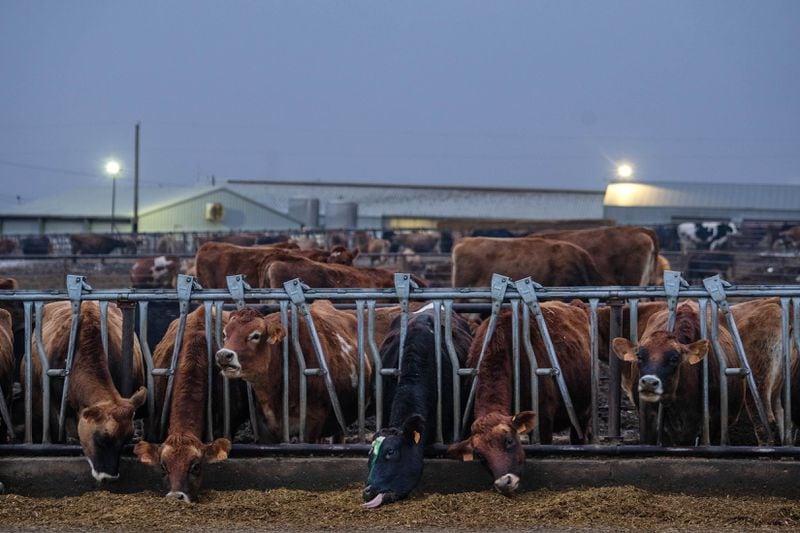Since 2022, a highly contagious strain of bird flu, has spread across the U.S. at an unprecedented rate, resulting in the deaths of more than 90 million birds in commercial and backyard poultry flocks, plus thousands more in the wild.
Then, in late March, the virus — known as H5N1 — made a jump to a mammal species that surprised many scientists: cows.
Dairy cattle in 34 herds in nine states have since tested positive for the virus, the U.S. Department of Agriculture’s (USDA) tracker showed on Tuesday. So far, there have been no reported cases in Georgia. But other developments are troubling influenza experts.
Testing throughout the week indicated the cases are likely far more widespread than first thought, according to scientists and federal authorities.
On Thursday, the Food and Drug Administration (FDA), said about one in five samples of commercially available pasteurized milk it has tested have contained inactive traces of the virus. The agency said it is conducting more analysis to confirm that heat treatment of pasteurization eliminates any possibility of infection, but added that early evidence shows the virus is neutralized in pasteurized, retail milk.
“To date, the retail milk studies have shown no results that would change our assessment that the commercial milk supply is safe,” the FDA said in a statement.
An employee at one of the Texas dairy farms with positive cases in its cows also contracted the virus, the Atlanta-based Centers for Disease Control and Prevention (CDC) confirmed April 1. The worker’s case is only the second-ever human case reported in the U.S. The man, who worked in close contact with cows and likely caught the virus from cattle, developed only a mild eye infection and has recovered.
The CDC says the threat to the general population remains low and the USDA says there are no signs the virus has changed in ways that could allow it to spread more efficiently to and among people. Still, experts say any transmission from mammals to humans is an unwelcome opportunity for the virus to adapt in ways that could heighten the risk to humans.
The coming weeks could be key to determining whether the virus’ emergence in cows is the start of a growing public health threat or not.
As the situation evolves, here’s what you need to know:
What is bird flu?
Highly pathogenic avian influenza (HPAI) — also known as bird flu — refers to the disease caused by a group of viruses that have spread among wild birds around the world for decades.
In birds, the virus spreads in fecal droppings and through respiratory secretions, causing lethargy, tremors, seizures and death. The virus’ high transmissibility, combined with the fact that most commercial poultry are kept in close quarters, means cases in poultry facilities typically require culling of entire flocks of tens of thousands of birds to stop the spread.
A growing list of land and marine mammals have also contracted bird flu, including seals, sea lions, mink, otters, foxes, cats and now, cows. Tens of thousands of mammals across at least 26 countries have died.
There have also been sporadic infections in humans, too, but typically only in people who have had close, unprotected contact with infected animals, primarily poultry. Since 1997, there have been 890 reported human infections globally with the H5N1 bird flu subtype prevalent among wild birds currently. Of those, roughly 50% of cases were fatal, but reported symptoms have varied widely, from none at all to severe disease. Overall, the CDC says the spectrum of illness caused by the strains circulating right now is unknown.
How did cows catch it?
Bird flu was likely originally transmitted to cows by wild migrating birds, according to a USDA memo published April 16. The agency adds there is now evidence of cow-to-cow spread in some recent cases.
The virus may have also spread from dairy cattle to nearby poultry and barn cats on some farms, too, but the exact pathways are not yet known. In the latest cases, the sickened cows have survived but other animals, including cats and poultry, have died.
Compared to birds, cows are experiencing mild symptoms: low energy, fever, dehydration and reduced appetite, plus thick, discolored milk and a decrease in production, the USDA says.
The raw milk of infected cows has been found to contain high concentrations of H5N1 and USDA has warned dairy workers to avoid any exposure to unpasteurized milk. To tamp down the spread, the agency has recommended “particular attention” to disinfecting milking equipment, as well as pens and other surfaces.
In the meantime, the USDA and the FDA both say that pasteurization has proven to kill viruses and bacteria, and there is no risk of infection from drinking commercial milk. And so far, the limited number of cases, plus cows’ relatively quick recovery from infection means there’s no threat to the country’s milk supply, for now.
Raw milk from sick cattle, however, has tested positive for the virus, and the CDC has urged people not to consume raw, unpasteurized milk. Dairy advocacy groups, like the Dairy Alliance, which represents farmers in Georgia and other Southeastern states, are echoing that sentiment.
“With raw milk, it’s always a risk, regardless of this virus,” said Geri Berdak, CEO of the Dairy Alliance, which counts roughly 75 farms in Georgia among its members. “There are absolutely no safety concerns with pasteurized milk.”
Why are cow cases worrisome?
Most humans aren’t regularly in close proximity to wild birds or many of the other mammals that have contracted bird flu during the current outbreak.
But cows are a domesticated species regularly in close contact with people on farms. That is troubling to Seema Lakdawala, an associate professor of microbiology and immunology at Emory University.
“I’m always concerned when bird viruses are getting into mammals ... but the cows are concerning because like pigs, they have a really extensive contact network,” said Lakdawala.
Pigs, which are vulnerable to both avian and flu viruses, have long been identified as a potential “mixing vessel,” where bird and human influenza viruses could recombine to create a new strain that spreads more effectively from person-to-person. So far, there’s no evidence this is occurring.
Credit: NYT
Credit: NYT
While bird flu has appeared in many mammal species during the current outbreak, cows were not considered likely candidates to catch the disease, experts say. Virologists have long known cattle were vulnerable to influenza type D viruses, but not influenza A viruses like the current bird flu strain, Lakdawala said. Influenza A is one of two main subtypes that typically cause illness in humans.
David Skallnecht, a professor emeritus at the University of Georgia’s College of Veterinary Medicine, said he didn’t expect cattle to catch the virus, but was not terribly shocked that they had.
“I don’t think anyone really saw this coming, but there’s one thing that needs to be clear: As far as susceptibility goes, you can probably infect anything on the planet with flu, if you give it the right dose and the right virus,” Skallnecht said.
The concern now, Lakdawala said, is whether the virus, as it circulates among cattle, could change in ways that make it more transmissible to humans, or from person to person.
“It’s not known how the virus will evolve in cattle and whether it will gain some of the mutations that we think of in terms of sensitivity to influenza in humans,” Lakdawala said.
What’s being done to stop the spread?
Georgia is not one of the country’s top-10 milk-producing states, but with an estimated 92,000 dairy cattle, it is still home to a robust milk industry.
Georgia’s response to the cases in dairy cows is being led by the Georgia Department of Agriculture (GDA) and its Commissioner, Tyler Harper. In a statement, Harper said his “team is in constant communication with our federal partners as well as dairy producers, veterinarians, and public health officials ... ”
So far, the GDA is hewing closely to the USDA’s latest guidance.
The USDA has urged dairy producers to monitor animals for signs of illness and to minimize the movement of cattle, along with a host of other recommendations. On Wednesday, the USDA announced new requirements for dairy cattle, ordering that cows be tested for the virus before being transported across state lines.
GDA spokesman Matthew Agvent said the state is working to implement the new rules before they take effect on April 29.
But while some states have restricted the import of cattle from regions with cases of the virus, Georgia has not. In a statement, Agvent said Georgia has imported cattle from states with positive cases, but no cows from affected herds have been brought to Georgia.
If a cow in Georgia does test positive, Agvent said movement of that herd “would be restricted and it would be monitored until clinical signs are resolved.” Agvent added that GDA is working closely with the Georgia Department of Public Health to develop an operational plan in the event that a human case does occur.
To prevent human cases, Agvent said the agency recommends dairy workers follow CDC guidance and wear personal protective equipment around cattle, and avoid contact with their eyes, nose, and mouth, among other measures.
What else?
In the CDC’s most recent update published Friday, the agency said it is possible there could be more human infections. But absent genetic changes that would make the virus more transmissible to people or evidence of sustained person-to-person spread, the agency reiterated its view that the virus poses a low risk to the general public
As of last week, the USDA said that it had not found any evidence the virus has mutated in ways that would allow it to spread more easily to and among people.
In the meantime, the CDC has begun testing FDA-approved antiviral drugs used against seasonal flu on the strain of virus that infected a worker in Texas. The agency said it found the virus was “susceptible” to all of those commercially-available drugs.
The CDC is also exploring whether existing candidate vaccine viruses could protect against this strain of bird flu, in case the mass production of vaccines is needed. The agency’s early analysis suggests two of those candidates would likely offer protection.
Amid the worry about the cow cases, other experts, like UGA’s Skallnecht, say we cannot lose sight of the toll the virus has taken on wild animals. The disease has ravaged populations around the world, including in species that had bounced back after decades-long conservation efforts, like the bald eagle and the California condor.
Though recent developments are concerning, Skallnecht said there are early signs that immunity is developing in certain bird species. If true, that could help pump the brakes on the virus’ unfettered spread in the wild.
“It’s probably not going to go away, but it may be less of a problem,” Skallnecht said. “That’s what we’re hoping for.”
Editor’s note: This story has been updated to correct the number of birds in commercial and backyard flocks that have been affected by the current avian influenza outbreak, and reflect new information and orders from federal agencies.
About the Author








